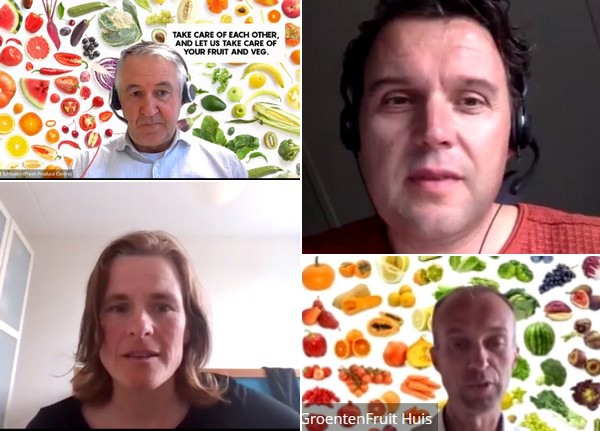In the Netherlands, in-person meetings still can't be held. So, this year, GroentenFruit Huis held a digital Fruit members meeting. About 25 members logged on, making attendance lower than usual.

Richard Schouten, Arne Bac, Cindy van Rijswick, and Wilco van der Berg
Top fruit
Cindy van Rijswick is a sector analyst and Arne Bac, a sector manager. They both work at Rabobank. They shared their top fruit, ‘Goedkoop fruit telen is te duur’ (Growing cheap fruit is too expensive) vision. They say the Dutch top fruit sector has a good image, certainly compared to other agricultural sectors. Farming is being done sustainably, and there's diversity. That creates room for different earning models. But, the market's saturated, and there's price competition and high costs.
The Rabobank representatives say club varieties don't guarantee high margins. For apples, domestic market prospects are good. But export opportunities are dwindling. For pears, this bank sees little room for expansion. The challenge is to maintain the current European export levels. However, Cindy and Arne do see chances for a truly distinctive pear. They think the sector as a whole will eventually develop more fixed chain relationships. Here, reciprocity will become increasingly important.
Growth possibilities
The discussion that followed showed that not everyone felt the same. Some disagreed with the conclusion that there's little growth opportunity for Conference pears. Someone mentioned that exports to the southern European countries could increase. That's provided the playing field with Eastern European countries is leveled.
But opportunities are also seen because Conference is a unique Dutch and Belgian product. Though, the attendees note that, in recent years, planting expansion has outpaced market development. Pricing-wise, there are concerns. These are about retailer development in various countries. They're increasingly working with tenders. That puts pressure on the market.
Someone raised another point. It seems the retail sector's current good results aren't reflected in pear prices. These good results are due to the global pandemic. That's partly because of the stock information retailers use. Those aren't always realistic. An attendee also mentioned that the supply's too fragmented. It's vital that the fruit sector cooperate more. They should form a bloc concerning supermarkets.
Strawberries
The top fruit market might be becoming saturated. The market for strawberries, however, keeps growing. Wilco van den Berg is a market analyst at GroentenFruit Huis. He says that last year, Dutch farmers harvested 78 million kgs of strawberries. More than three-quarters of that was produced under cover: in greenhouses or tunnels. He notes that from 2010 onwards, using greenhouses has accelerated strawberry production.
That acreage is still increasing. That's in contrast to outdoor cultivation, which has been shrinking since 2015. Production has grown enormously, but this doesn't apply to exports. These have remained stable at around 60 million kgs. The domestic market has absorbed almost all the increasing strawberry production. Consumption has risen to 45 million kgs in the past two years.
Wilco says this ever-increasing production means several retailers offer Dutch strawberries year-round. That's a positive development. He's mainly considering chances outside of the Netherlands to boost sales. Dutch consumption will hit a ceiling sometime.
Blueberries
Concerning blueberries, the market analyst sees that the Netherlands has a strong position in global trade. In 2020, imports passed the 100 million kg mark. The berries, worth €600 million, came mainly from Peru and Chile. These were primarily sold in Germany and the UK. Wilco sees that annually, blueberry sales in the Netherlands are still rising sharply. There are also still new buyers. He expects blueberry demand to grow in a similar way to the development in Germany and the UK. However, the Dutch position in world trade remains important.
 For more information:
For more information:
GroentenFruit Huis
Tel: +31 (0) 793 681 113
EMail: info@groentenfruithuis.nl
Website: www.groentenfruithuis.nl
